John Healy (draft 6-18-2024, 7-22-2024)

1 Introduction
What might be expected if you asked, à la a Jay Leno “Jaywalking” segment [1], some random people this question: “How big is a photon?“
Well, aside from cases where the reply is “What’s a photon?” … something about light? … maybe a general sense of scale (something about atoms?) … maybe a technical measure (unit of length?) …
When I asked an aerospace engineer with a degree in physics, his answer included a standard rule-of-thumb (heuristic) for waves.
The word “photon” is not an everyday word. Like “energy,” it’s not something that you can point at. So, it’s not like asking “How big is a human being?” Or “How tall is a tree?” – which may elicit the notion of range. And it’s not like asking “How big is a baseball” (or a tennis ball or a golf ball) – which is a standardized object.
Anyway, personally I think the question might a good starting point for an introductory physics class, rather than what my freshman college physics class used, namely, the double-slit experiment.
The photon’s tale – the teaser
- Photons are quanta of the electromagnetic field.
- Quanta can be big!
Although most quantum physics is done at molecular, atomic, and subatomic scales, this size-based definition is oversimplified because quanta aren’t necessarily small; they can, in fact, be as big as Earth (Chapter 5). And two or more “entangled” quanta (Chapter 9) can be considered a single composite quantum, the parts of which are intimately unified and capable of influencing each other instantaneously even if they inhabit different galaxies. – Hobson, Art. Tales of the Quantum: Understanding Physics’ Most Fundamental Theory (p. 17). Oxford University Press. Kindle Edition.
2 Overview
- The term photon originated in 1926.
Modern space (and ground) telescopes detect individual photons which have traveled for billions of years across space, making an image dot-by-dot on their light sensors.
So, to answer the question, because it has no easy answer (even without being a trick question), there’s a saga – of understanding our everyday (macroscopic) world and then exploring the invisible (microscopic) grounding of that everyday experience.
- Even ancient observers noticed that there was a difference in how soon we saw & heard a distant event, like an explosion. But appreciating that even light traveled at a limited speed took awhile (1676).
- And naturally water waves … and eventually that sound was a wave as well.
- Wiki, among others, provides historical recaps of radio transmitters and receivers and the mathematical framework of radio waves.
- And finally the realization that visible light was another part of the electromagnetic spectrum that includes radio waves and other invisible waves (1888).
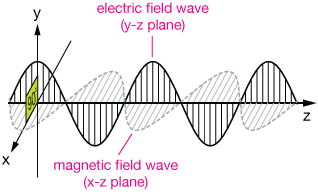
- In physics, analogies to light & water waves (and vibrating strings) remained practical for early models of the atom. Until some puzzling experiments, which introduced a quantum framework [3].
Personally, the hard part has been the jumbled application of macroscopic models – useful simplifications of everyday physical phenomena – to their granular unseen constituents – to their “atomicity.”
The tendency to think of quanta as tiny but ordinary objects, like a sand grain only smaller, is even stronger when the quantum is an atom or other composite material object. But atoms are waves too, and they can be superposed, as can large molecules made of many atoms, as we’ll see later.” – Tales of the Quantum: Understanding Physics’ Most Fundamental Theory by Art Hobson [6]
Even today I do not find that transition – from the microscopic to the macroscopic – typically well explained (visualized). For example, as to how zillions of individual photons from a radio transmitter combine into continuous macroscopic waves (wavefronts) with wavelengths spanning great (perhaps indefinite) distances [4].
So, is wavelength a good measure of a photon’s size?

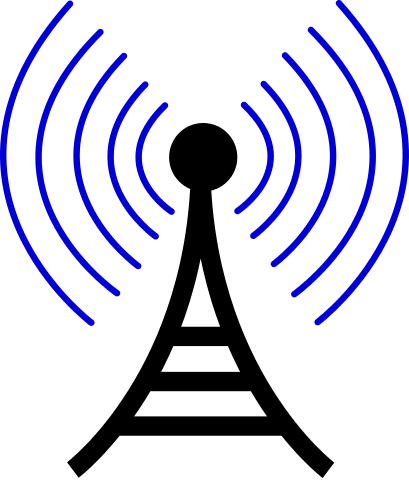
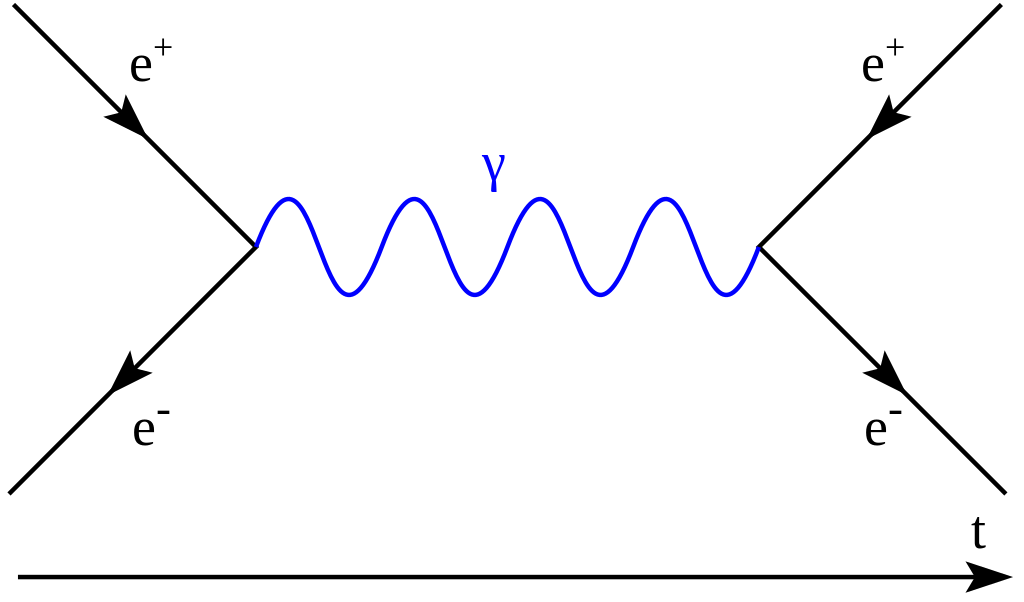
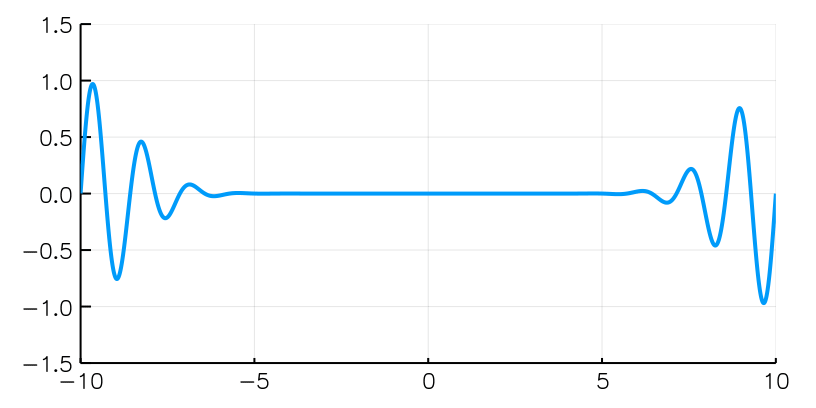
3 Size = Wavelength?
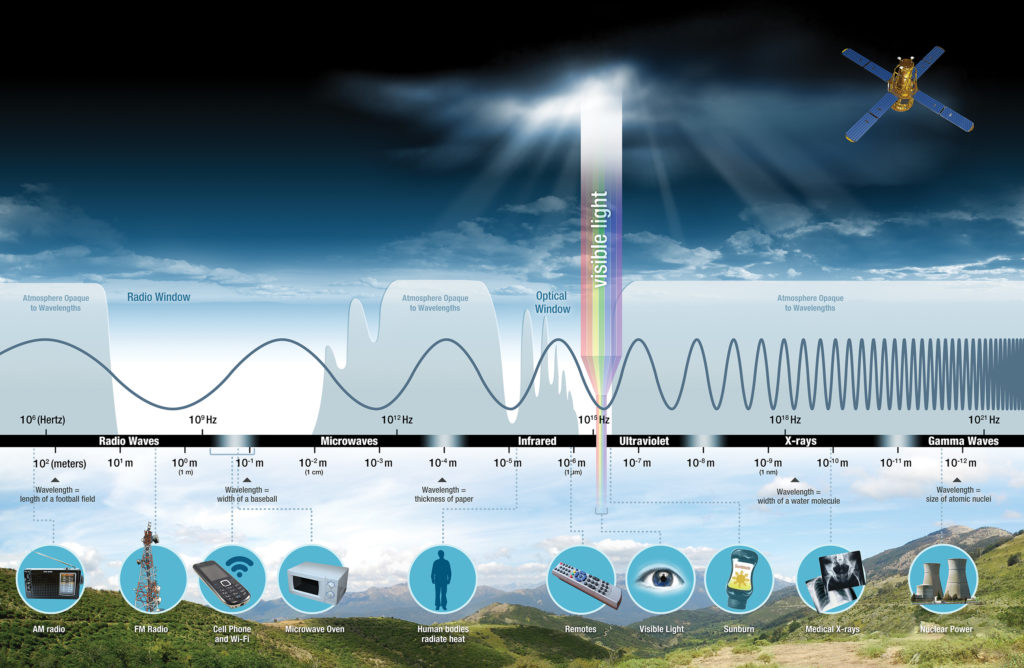
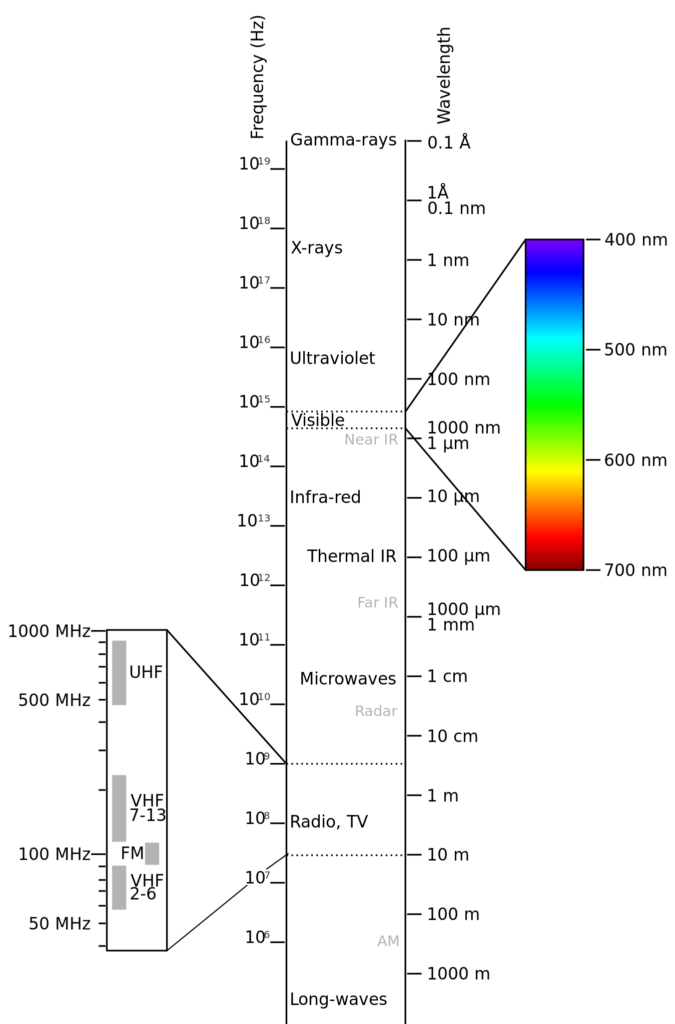
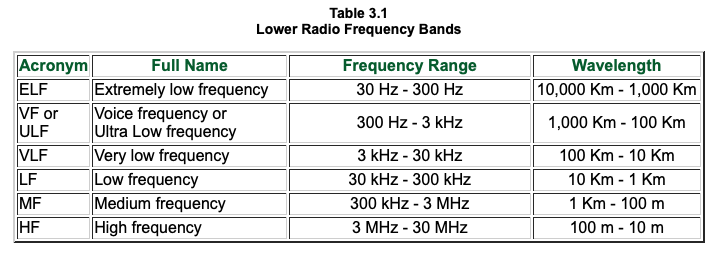
Photons are 3-D (at least). Typical visualizations show 2-D graphs (waveforms). What does a 3-D photon with a wavelength of 10 miles look like? What does a wavefront with a wavelength of 1000 miles look like? “Point-like” need not apply, eh.
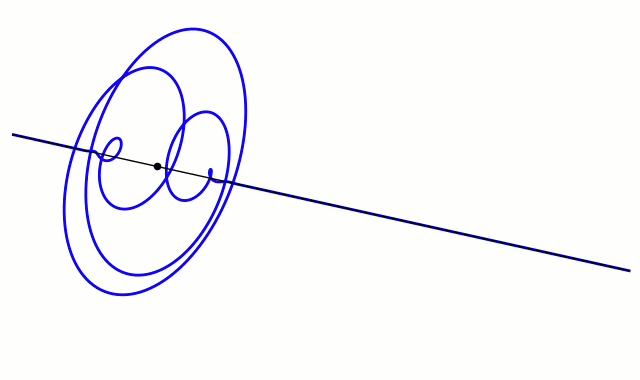
4 Size = Punch power (energy density)?
How does wavelength connect with our everyday experience? – other than for our vision and personal electronics (WiFi, Bluetooth)? Well, wavelength matters. For most people, for skin health, visible light is not an issue. Read the labels on sunscreens, however, and it’s all about UV, which penetrates skin layers – ionizing radiation.

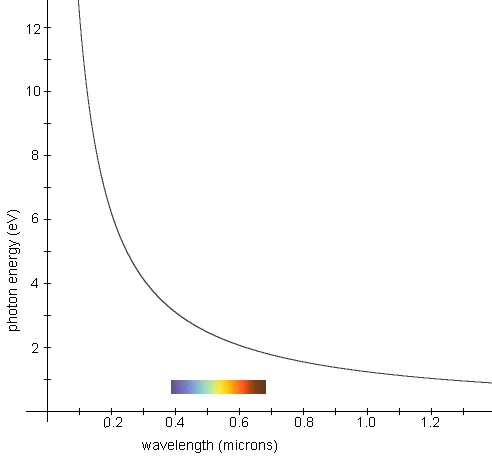

5 Wavepacket Complications (technical stuff)
Superposition set size (Fourier synthesis / series)
To make sense of superposition, you must visualize quanta as waves in fields. The common picture of quanta as tiny things, like billiard balls only smaller, contradicts the extensive experimental evidence of superposition.” – Tales of the Quantum: Understanding Physics’ Most Fundamental Theory by Art Hobson
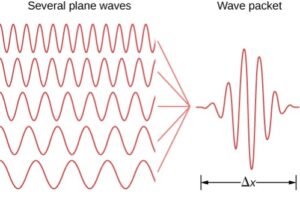
Regarding wavepackets as extended in space, Art Hobson (ibid.) uses the Mach–Zehnder interferometer as a key example of extended superposition.
Wiki > Mach–Zehnder interferometer: “From this we can conclude that the photon does not take one path or another after the first beam splitter, but rather that it must be described by a genuine quantum superposition of the two paths.”
Wavepacket tails
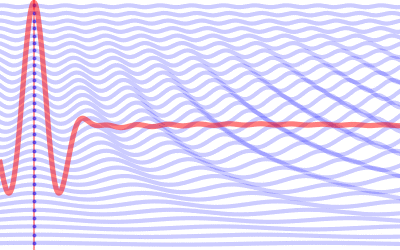
What if the tails of wavepackets extend indefinitely? – are essentially infinitely long (in mathematical terms, asymptotic to “zero” amplitude). In practice, such tails are negligible at some scale (and typical visualizations leave this aspect hazy).
Wavepackets are highly localized (discrete) field excitations; yet, are superpositions of a potentially-infinite set of sinusoidal waves. So, “spread over an infinite spatial region.”
How does that alter the notion of a photon’s size?
In physics, a wave packet … is a short burst of localized wave action that travels as a unit, outlined by an envelope. A wave packet can be analyzed into, or can be synthesized from, a potentially-infinite set of component sinusoidal waves of different wavenumbers, with phases and amplitudes such that they interfere constructively only over a small region of space, and destructively elsewhere. Any signal of a limited width in time or space requires many frequency components around a center frequency within a bandwidth inversely proportional to that width … – Wiki
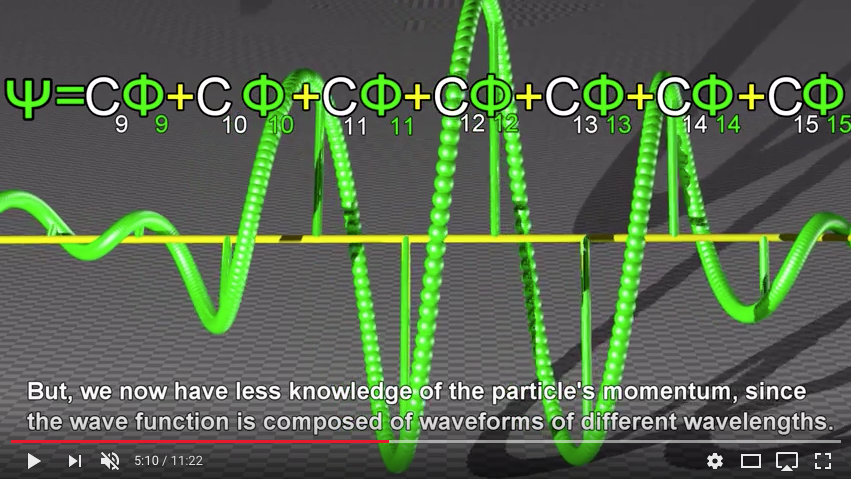
Soliton?
• Springer Link > “The Photon as a Soliton” by P. Kamenov & B. Slavov (Published: 11 January 2014) Volume 11, pages 325–342, (1998)
Recently J. P. Vigier showed [1] that the photon can be represented as a solitary electromagnetic wave – a soliton. As a consequence one can ascribe to such a soliton effective volume, amplitude and frequency which coincide with the frequency of de Broglie’s wave (measured by interference phenomena). In this paper we propose a soliton-like model for the photon. … We show that there are no essential contradictions between our photon-soliton and some well-known facts such as the interactions in the case of photoeffect and Compton effect.
• Physicsforums.com > “Is regular light considered a soliton?” Thread starter FlyTy Start date Dec 18, 2009 Tags Light Wave
In summary, solitons are solitary waves that maintain their shape and speed, while light waves are electromagnetic waves that carry energy and information. Solitons can be generated through nonlinear interactions or specific shapes, while light waves are generated by accelerating particles or vibrating fields. Solitons and light waves can interact through soliton-soliton interaction. They have practical applications in various fields. Solitons and light waves can travel at different speeds depending on the medium.
While light can exhibit some characteristics of a soliton, it is not considered a true soliton in the traditional sense. Solitons are typically defined as waves that maintain their shape and energy while propagating through a medium without losing intensity or dispersing. While light does experience some dispersion and attenuation as it travels through a medium, it is able to maintain its energy and shape over long distances. However, this is due to the nature of light as an electromagnetic wave, rather than its classification as a soliton. Additionally, the speed of light is constant and does not slow down or run out, further differentiating it from true solitons. While light may exhibit some soliton-like behavior, it is not considered a soliton in the strictest sense.
Notes
[1] Jaywalking: Leno asks people questions about current news and other topics in public areas around Los Angeles … Most responses are outrageously incorrect; for example, one person believed that Abraham Lincoln was the first president, and another could not identify a picture of Hillary Clinton. Sometimes the questions are of the “What color is the White House?” level, …
[2] Physics-related tropes in general circulation:
- E = mc^2 (Einstein)
- Big Bang
- Schrödinger’s cat
- Dark matter
- Multiverse
• Study.com > “Trope | Definition, Types & Examples“
[3] How quantum physics changed the “ball game” –
Before 1900, scientists thought identical conditions led to identical results. Well, they don’t. Nature contradicts this plausible principle predicted by “classical physics” throughout the period 1650 to 1900, according to which the universe is precisely predictable the way an accurate clock is predictable. – Ibid. Hobson, Art. (p. 2).
[4] For example, as noted in this course on the EM Spectrum:
The superposition of a sufficiently large number of photons has the characteristics of a continuous electromagnetic wave.
[5] I did not realize that this was an open area of research – a photon’s mass. Wiki notes that: “Current commonly accepted physical theories imply or assume the photon to be strictly massless.”
• Science Alert > “How Heavy Can a Particle of Light Be? Scientists Just Figured It Out” by Michelle Starr (18 June 2024) – According to measurements of pulsing stars scattered throughout the Milky Way and mystery radio signals from other galaxies, a particle of light – called a photon – can be no heavier than 9.52 × 10^-46 kilograms.
Photons, typically, are described as massless particles [hmm]. These discrete quantities of energy zip through space-time at a constant speed, unable to accelerate or slow down in a vacuum. This constant velocity implies masslessness, and there isn’t evidence to the contrary.
However, we don’t know for absolute certainty that photons are massless. A non-zero mass would have profound implications.
If photons have mass, their propagation through non-vacuum space populated by plasma would be affected both by the mass and the free electrons in the plasma. This would lead to a delay time proportional to the mass of the photon.
[6] Re “atoms are waves too,” here’s an article about imaging atoms in an optical matrix.
[The same research is noted in Philip Ball’s Chemistry World (June 13, 2024) article by my post “Demystifying quantum mechanics > The baggage of behind (popsci tropes) > wave-particle duality.” As well as in the New Scientist article below.]
• Live Science > “Stunning image shows atoms transforming into quantum waves — just as Schrödinger predicted” by Ben Turner (May 1, 2024) – Physicists have captured clear images of atomic wavepackets (atoms) as discrete dots when confined (boxed in) and as fuzzy blobs when “free.”
This (paywall) article embraces the legacy trope of wave-particle duality by using the “morphing” metaphor.
• New Scientist > “Single atoms captured morphing into quantum waves in startling image” by Karmela Padavic-Callaghan (22 April 2024)
References
• Big Think > “What is a quantum particle really like? It’s not what you think” by Don Lincoln, Fermilab (September 19, 2023) – “It is completely reasonable to think of subatomic particles like electrons and photons as wave packets, …”
Given that traditional particles and waves seem to have such very different properties, it is easy to understand how early 20th century physicists were so confused as they tried to reconcile claims that things like photons and electrons were both particles and waves.
For example, an object like an electron has a wavelength, but it doesn’t extend off to infinity. Instead, the amplitude (or height) of the wave has a location where it is maximized, and then it decreases at distances farther from the maximum. The result is what is called a wave packet.
“Photons are very, very easy to create.” Are photons easy to destroy?
Do photons ever get “tired” traveling through the cosmos? Like wane away (unlike merely diffracting)?
Siegel still uses phrases like “collide and interact” for quanta (field excitations). Why not just interact?
• Big Think > “Is it true that photons truly live forever?” by Ethan Siegel (August 15, 2024) – Here’s the best answer that science has today.
… once the light leaves its source, the only way you could change its frequency was to either:
- have it interact with some form of matter and/or energy,
- have the observer moving either toward or away from the observer,
- or to have the curvature properties of space itself change, such as due to a gravitational redshift/blueshift or an expansion/contraction of the Universe.
Each and every photon that’s produced … will stream through the Universe until it collides and interacts with another quantum of energy. … with your [its] wavelength stretching due to the Universe’s expansion … [and so] simply redshift and redshift until you’re [its] below the longest possible wavelength that will ever allow you [it] to be absorbed [by a quantum bound state] ever again.
So will they [photons] ever die out? … You can think of every photon that was or will be:
- created in the Big Bang,
- created from quantum transitions,
- created from radiative corrections,
- created through the emission of energy,
- or created via black hole decay,
and even if you wait for all of those photons to reach arbitrarily low energies due to the Universe’s expansion, the Universe still won’t be devoid of photons. … Because the Universe still has dark energy in it [will never reach absolute zero].
